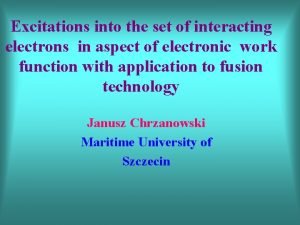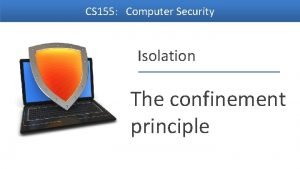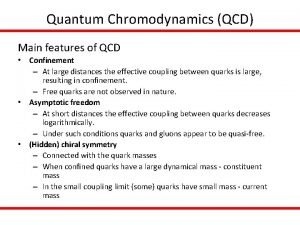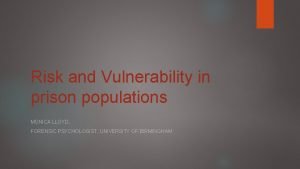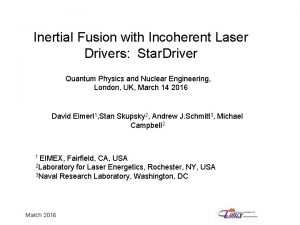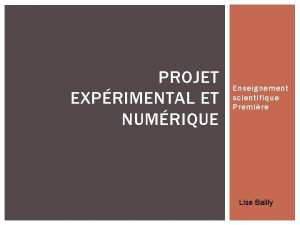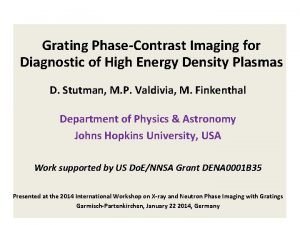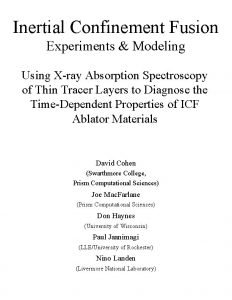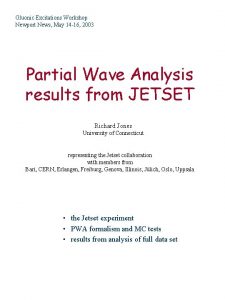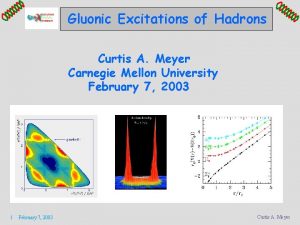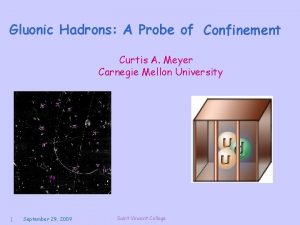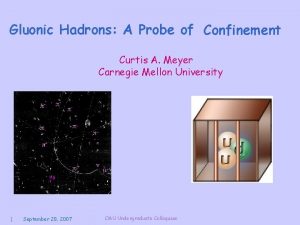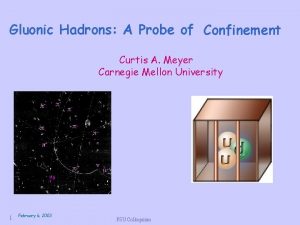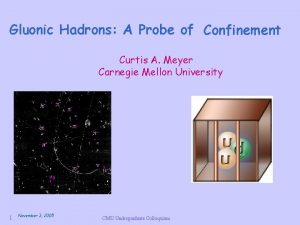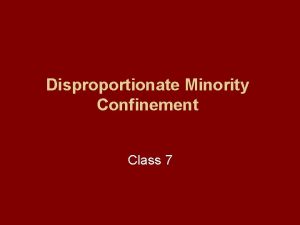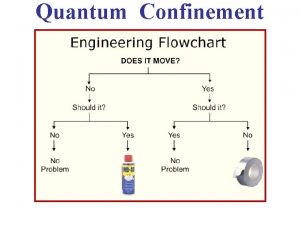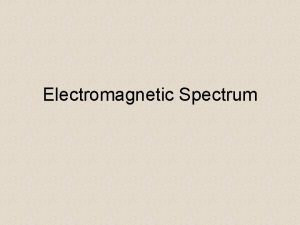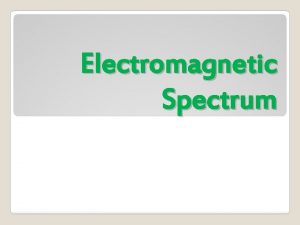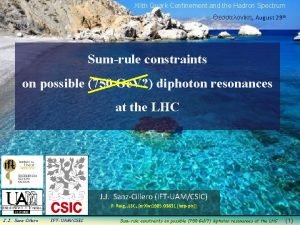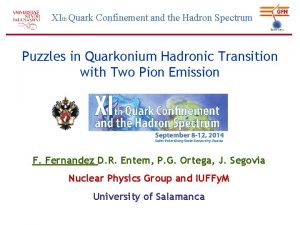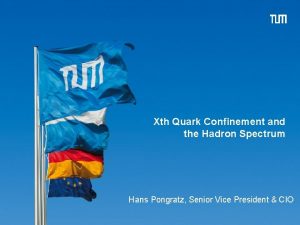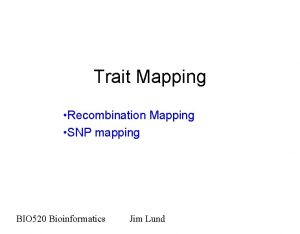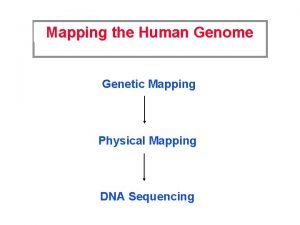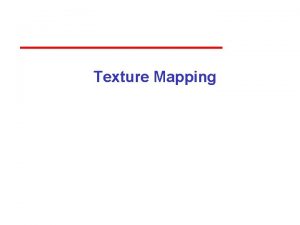Mapping the Spectrum of Gluonic Excitations Confinement in





























- Slides: 29

Mapping the Spectrum of Gluonic Excitations & Confinement in QCD Alex Dzierba Spokesperson Glue. X Collaboration DOE NP Division Science Review of the JLab Upgrade April 6 -8, 2005 The Glue. X/Hall D Project QCD predicts a rich spectrum of - as yet to be discovered gluonic excitations - whose experimental verification is crucial for an understanding of QCD in the confinement regime. With the (a) upgraded CEBAF, (b) linearly polarized photon beam and (c) the Glue. X detector, Jefferson Lab will be uniquely poised to: (1) discover these states, (2) map out their spectrum and (3)

The Fundamental Science Issue • The failure to observe isolated quarks or gluons provides overwhelming experimental evidence that hey are confined in nature. • A quantitative understanding of the confinement of quarks and gluons in quantum chromodynamics (QCD) is one of the outstanding fundamental questions n physics. • QCD is our preeminent example of a strongly-coupled field heory. • Understanding QCD in this long-distance regime - as a stronglycoupled field theory - is an outstanding challenge, not only for hadronic physics, but also for all theoretical physics. it is likely that physics at the LHC and beyond • For example, has strongly-coupled sectors and QCD provides an analogy or constructing new theories such as technicolor.

from first-principles LQCD: Gluonic Excitations and Confinement The quarks in a meson are sources of color electric flux and that flux is trapped in a flux tube connecting the quarks. The formation of the flux tube is related to the selfinteraction of gluons via their color charge. Flux tubes lead to a linear confining potential. that Action Density G. Bali - heavy quarks - quenched • Do flux tubes apply in detail to light-quark systems? - still an open question • In LQCD the excited gluonic field has J PC quantum numbers couple with those of the quarks to produce mesons with exotic quantum numbers. This spectrum is the window to QCD in the non-perturbative regime.

Conventional and Hybrid Mesons With the flux tube in its ground state the conventional mesons result - their quantum numbers are determined solely from the quark degrees of freedom: q q these exotic combinations not allowed: With the flux tube in its excited state the hybrid mesons arise and the QN of the excited flux tube combine with those of quarks giving rise to hybrid mesons With three light quarks the conventional and hybrid mesons form flavor nonets - for each u d s

Masses and Widths of Hybrid Mesons Masses and Widthswidths are expected to similar to those of conventional strongly-decaying mesons LQCD Mass Predictions for: LQCD Mass Predictions for other exotic

Decay Modes of Hybrid Mesons Decay Modes Selection rule (though not absolute): the hybrid meson cannot transfer its angular momentum to the final state meson pairs as relative angular momentum, but instead to the internal angular momentum. favored modes: suppressed modes: The more complicated nature of the favored modes may explain why they might no Examples: check various modes to certify PWA results

Have Exotic Hybrids Been Observed? All of the following are reports of exotics Observed in the charged mode by E 852 and confirmed by Crystal Barrel in charged/neutral modes. P-wave observed in neutral mode but not resonant. This state is controversial. Hint of an exotic signal in the mode based on an analysis of 250 K events. A recent analysis of 3 M and events (each) shows no exotic. More on this. . . Large P-wave present but not clear if it is resonant. Reported by E 852. Statistics are relatively low and confirmation is needed.

Production of Hybrid Mesons Combine excited glue QN with those of the quarks: exotic excite the glue produced hybrids are not expected to be exotic produced hybrids can be exotic

Strategy for Hybrid Meson Discovery • Initially focus on hybrids with exotic J, P and C quantum numbers thus avoiding ambiguities from mixing with conventional mesons. • Identify several members of a given exotic nonet and establish more than one exotic nonet. • Have a meson mass reach up to 2. 5 Ge. V. • Use a photon probe as suggested by previous arguments. • Data from photoproduction of light-quark mesons are sparse highlighting the importance this for searches. • Optimize the detector, the probe of and thevenue analysis tools (software and phenomenology) to carry out a partial wave analysis (PWA) needed to unambiguously identify the meson quantum • Be sensitive to a wide variety of decay modes needed to numbers. certify the PWA results and to compare with LQCD predictions.

Requirements for Hybrid Meson Discovery Will Be Met by the Upgrade • Photon beam with sufficient energy for the mass reach. – 9 Ge. V photons ideal. • Linearly polarized photons of a degree and flux needed for the PWA. – Using coherent bremsstrahlung this implies 12 Ge. V electrons with the appropriate emittance, spot size and duty • Detector optimized for PWA and detecting a variety of decay factor. modes. – The Glue. X detector design optimizes: (1) hermeticity (2) energy and momentum resolution (3) particle identification (4) data rate

Meson Production Kinematics Yields Variation of t energy: as a function of meson mass and photon min • affects production rate and • line shape (if t varies rapidly across width min of resonance)

Line Shapes and Photon Energy Start with resonances of same width and production crosssections. The final yield and line shape determined by peripheral production and kinematics.

Linear Polarization assume that X decays into two spin-less mesons: a and b and that e is also spin-less quantization axis m determined by polarization of photon For circularly polarized photons: m = +1 or m = – 1 For unpolarized photons: equal mixture of m = +1 and m = – 1 For x - linear polarization: For y - linear polarization:

Linear Polarization Exotic Production: Takes place via unnatural (U) parity exchange Diffractive Production: Through natural parity (N) Unpolarized or circular polarized exchangecannot distinguish photons between U and N. With longitudinal polarization one can distinguish by selection based on the angle the polarization vector makes with the production plane.

Coherent Bremsstrahlung provides linear polarization and with collimation reduces backgrounds from low-energy incoherent photons 12 Ge. V electrons

Ideal Photon Beam Energy Based on: - meson yield for high mass region - maintain sufficient beam flux/polarization - separate baryon from meson resonances - assume 12 Ge. V electrons

Need for 12 Ge. V electrons 9 Ge. V photons ideal for the meson mass reach and is wellmatched to solenoidal detector. Keep the photon energy fixed at 9 Ge. V and vary the energy of the electron beam to understand the figure of merit. Conclusion: 12 Ge. V electrons essential 10 Ge. V 11 Ge. V 12 Ge. V Photon flux in peak (million per sec) 32 67 100 Average degree of polarization 0. 08 0. 24 0. 37 Figure of merit relative to 12 Ge. V 0. 015 0. 263 1. 0 electron energy: total hadronic rate fixed at 370 k. Hz

Exotic Hybrid in the 3π System? - E 852 In 1998 - E 852 published evidence for an exotic meson: PWA based on the isobar model:

Decay angles Correlated angular distributions for representative partial waves Gottfried-Jackson frame Helicity frame

The Analysis 1998 analysis based on 250 K events of reaction (a). New nalysis is based on 3 M events each of reactions (a) and (b). The two odes provide important cross-checks. (a) (b) PWA shows: fits: two interfering Breit-Wigners as expected from isospin

PWA Has A Large Dynamic Range

Moments and PWA Moments provide an arbiter for wave set sufficiency compare moments calculated from data and from PWA Number of waves used in old analysis - 21 waves (low-wave set) Number of waves used in new analysis - 35 waves (high-wave set) Agreement with moments better with high wave set.

Results of the New Analysis • Wave set that has a better agreement with moments does not show evidence for the exotic meson.

What Have We Learned From E 852? • The PWA reliably extracts resonances with cross sections that differ by factors of 50 to 100. Line shapes and relative phases • Highare statistics and cross checks provided by different decay understood. modes are important in establishing states with lower cross sections - as with the recent higher statistics analysis of the system in two modes. • E 852 data are providing an important test bed for understanding the PWA its phenomenological underpinnings. • Glue. X willand have: - superior acceptance and resolution - a probe (photon) expected to yield exotic hybrids - statistics that exceed E 852 by several orders of magnitude

Glue. X Detector Design is mature: - based on 6 years of optimization and R&D on subsystems - well matched to 9 Ge. V photon beam

Acceptance in Decay Angles Recall the rich structure in these angles for various partial waves

Data and Analysis Plans • Glue. X will collect about 1 Peta. Byte/year. • After 3 -4 years of initial running Glue. X will collect statistics hat will exceed existing data on light-meson production by several orders of magnitude. • Software tools to handle these data sets are being developed. We will make extensive use of GRID-based tools as they become • We are also working closely with physicists at CLEO-c searching available. for glueballs in radiative decays) - to develop echniques to unambiguously identify gluonic excitations. A white paper is in preparation.

In the first 5 years. . • Glue. X will establish the existence of a exotic in several modes if it is present at a level of a few % of conventional mesons. If exotics are not present - the few % level will be the exclusion limit enough to present problems for QCD as we know it. • Glue. X will measure branching modes for established exotic states to validate QCD predictions. • Glue. X will also add to the knowledge of conventional meson spectroscopy especially strangeonium states that straddle the light and heavy quark sectors. In the next 5 years. . • Glue. X will establish other exotic hybrid states and nonets along with non-exotic hybrids.

Conclusions • Mapping the spectrum of hybrid mesons provides the critical experimental information needed to answer a fundamental question: the nature of confinement in QCD. • Advances in science follow advances in technology and the recent advances in detectors/readout, computational power, diamond wafers (for coherent bremsstrahlung) put us in position to achieve thetoexperimental goals. with the • Withathe upgrade of CEBAF 12 Ge. V - coupled superb electron beam characteristics - JLab will be in a unique position to discover and map the spectrum of hybrid mesons.
 Threshold frequency
Threshold frequency Confinement principle in computer system security
Confinement principle in computer system security Confinement qcd
Confinement qcd Solitary confinement effects
Solitary confinement effects York will end longterm solitary jails
York will end longterm solitary jails Inertial confinement
Inertial confinement Exemple projet enseignement scientifique 1ère
Exemple projet enseignement scientifique 1ère Inertial confinement
Inertial confinement Inertia xray
Inertia xray Shape of s orbital
Shape of s orbital Absortpion
Absortpion Memory parameters
Memory parameters Forward mapping vs backward mapping
Forward mapping vs backward mapping Terjemahan
Terjemahan đặc điểm cơ thể của người tối cổ
đặc điểm cơ thể của người tối cổ Hình ảnh bộ gõ cơ thể búng tay
Hình ảnh bộ gõ cơ thể búng tay Mật thư tọa độ 5x5
Mật thư tọa độ 5x5 Tư thế worms-breton
Tư thế worms-breton ưu thế lai là gì
ưu thế lai là gì Thẻ vin
Thẻ vin Cái miệng xinh xinh thế chỉ nói điều hay thôi
Cái miệng xinh xinh thế chỉ nói điều hay thôi Các châu lục và đại dương trên thế giới
Các châu lục và đại dương trên thế giới Bổ thể
Bổ thể Từ ngữ thể hiện lòng nhân hậu
Từ ngữ thể hiện lòng nhân hậu Diễn thế sinh thái là
Diễn thế sinh thái là Tư thế ngồi viết
Tư thế ngồi viết V cc
V cc Thể thơ truyền thống
Thể thơ truyền thống Làm thế nào để 102-1=99
Làm thế nào để 102-1=99 Bài hát chúa yêu trần thế alleluia
Bài hát chúa yêu trần thế alleluia
